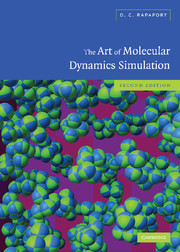Book contents
- Frontmatter
- Contents
- Preface to the first edition
- Preface to the second edition
- About the software
- 1 Introduction
- 2 Basic molecular dynamics
- 3 Simulating simple systems
- 4 Equilibrium properties of simple fluids
- 5 Dynamical properties of simple fluids
- 6 Alternative ensembles
- 7 Nonequilibrium dynamics
- 8 Rigid molecules
- 9 Flexible molecules
- 10 Geometrically constrained molecules
- 11 Internal coordinates
- 12 Many-body interactions
- 13 Long-range interactions
- 14 Step potentials
- 15 Time-dependent phenomena
- 16 Granular dynamics
- 17 Algorithms for supercomputers
- 18 More about software
- 19 The future
- Appendix
- References
- Function index
- Index
- Colophon
12 - Many-body interactions
Published online by Cambridge University Press: 28 February 2011
- Frontmatter
- Contents
- Preface to the first edition
- Preface to the second edition
- About the software
- 1 Introduction
- 2 Basic molecular dynamics
- 3 Simulating simple systems
- 4 Equilibrium properties of simple fluids
- 5 Dynamical properties of simple fluids
- 6 Alternative ensembles
- 7 Nonequilibrium dynamics
- 8 Rigid molecules
- 9 Flexible molecules
- 10 Geometrically constrained molecules
- 11 Internal coordinates
- 12 Many-body interactions
- 13 Long-range interactions
- 14 Step potentials
- 15 Time-dependent phenomena
- 16 Granular dynamics
- 17 Algorithms for supercomputers
- 18 More about software
- 19 The future
- Appendix
- References
- Function index
- Index
- Colophon
Summary
Introduction
The range of problems amenable to study using MD knows few bounds and as computers become more powerful the range continues to expand. Because of the enormous breadth of the subject, we have chosen to concentrate on the simplest of systems and avoid overly specialized models. Most of the case studies up to this point have been based on short-ranged, two-body interactions; within this framework a considerable variety of problems can be studied, but a few conspicuous gaps remain. Pair potentials have their limitations, and while certain kinds of intermolecular interaction can be imitated by the appropriate combinations of pair potentials, it is sometimes essential to introduce many-body interactions to capture specific features of the ‘real’ intermolecular force [mai81].
In this chapter we present two different approaches to the introduction of many-body interactions, namely, three-body interactions and the embedded-atom method, each in the form of a case study. We cannot do justice to the range of applications to which these and other enhancements of the MD method, such as those discussed in Chapter 13, have contributed, but in the prevailing culinary atmosphere we hope the reader will gain at least a taste of what is involved.
Three-body forces
The problem
Even when regarded simply as effective potentials, the capacity of the pair potential to reproduce known behavior has its limitations.
- Type
- Chapter
- Information
- The Art of Molecular Dynamics Simulation , pp. 326 - 343Publisher: Cambridge University PressPrint publication year: 2004



